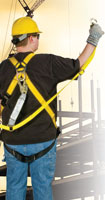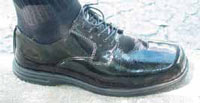
July 2009
- FALL PROTECTION: Accommodating Heavy Workers
- RISK MANAGEMENT: Manage Your Chemicals the Right Way
- FOOT PROTECTION: G4S Wackenhut Stops Slips & Falls
- SAFETY FROM THE TOP: Dr. Louis Sullivan on Disaster Planning
Click here to subscribe.
Features
By Jerry Laws
The American public's concern about potentially pandemic influenza A(H1N1) waned in early May as schools in some affected states reopened and Mexico appeared to have its outbreak in hand. The number of confirmed cases and countries in which they were found continued to rise steadily, however, primarily in the Americas and Europe, the World Health Organization reported.
By Michael Rosen, Todd Spaulding
Total annual health care costs reached $2.4 trillion in 2008 and are projected to reach $3.1 trillion in 2012. In fact, there appears to be no end in sight to this trend.1 As a result, organizations and individuals continue to search for strategies to deal with escalating health care costs that are outpacing the rate of inflation.
By Karen D. Hamel
Each year when federal statistics are released, it comes as little surprise that violations of OSHA's Hazard Communication Standard are among the top 10 safety citations issued to general industry. With more than 4,000 violations issued each year, OSHA continues to make it quite clear that having a dusty, nearly empty binder of MSDS wedged on the top shelf of someone's office is not enough.
By Bob Gerow
Imagine you've been thrust into the cockpit of a packed commercial airliner on its final approach, you've never piloted an airplane—and now, you're at the controls. "Scary" doesn't begin to describe how almost anybody would feel in a situation that pressure-packed and urgent.

By Barbara Mulhern, T.J. Lentz
In Alabama, a framing crew member who was moving a roof truss into place while supporting himself on an 8-inch wide structural beam fell 27 feet to the ground inside the partially constructed building. The native Mexican laborer, who understood little English, was not wearing or using personal fall protection equipment. An 8-foot by 4-foot truss fell at the same time, striking the worker's head when he hit the ground. He was pronounced dead at a local hospital.

By Marc Harkins
User weight is an important consideration when determining personal protective equipment for workers. Most fall protection product capacity rates up to 310 pounds, a weight aligned with most safety standards' and regulations' test criteria. Users should note that product capacity is more than just user weight, because it includes all clothing and equipment attached to the worker.
By Louis W. Sullivan
Whether in the public or private sector, risk managers with limited resources are constantly faced with the challenge of prioritizing competing concerns, managing the desire to take all possible steps to protect the organization and its employees. In today's economic climate, shrinking budgets are the norm, and securing funding for things like emergency preparedness can be difficult.

By Jerry Laws
G4S Wackenhut tried out a new slip-resistant shoe with about 800 security officers at two offices in Cincinnati and Fort Myers, Fla., early this year. Asked April 28 how the trial was going, Director of Safety Frank Knapfel said the results were excellent at that point in the trial.

By Christopher Gaskill, William Weems
The voice is the primary occupational tool for many professions, yet rarely do we think about the demands placed on the human voice. If a famous singer cancels a concert tour due to a voice problem—that might make the news. Yet every day, millions of Americans spend the majority of their work day using their voice in some capacity, especially workers such as salespersons and schoolteachers.
Departments
By Janet Iachini, M.Ed., ASCM/HFI
Picture this, if you will: An administrator looks at a year-end injury/accident report, head propped up by one hand and one finger across the lips with a baffling look of "Why are these costs so high?" Or picture a department's leader not reporting a small injury on the last day of a flawless (injury-free) month and saying, "I want my bonus for an injury-free month
By Robert Pater
One of leadership's biggest blockages is failing to acknowledge real problems. It's easier for some to focus on issues of which they think they have control rather than tackle longstanding, seemingly insolvable, obstacles.